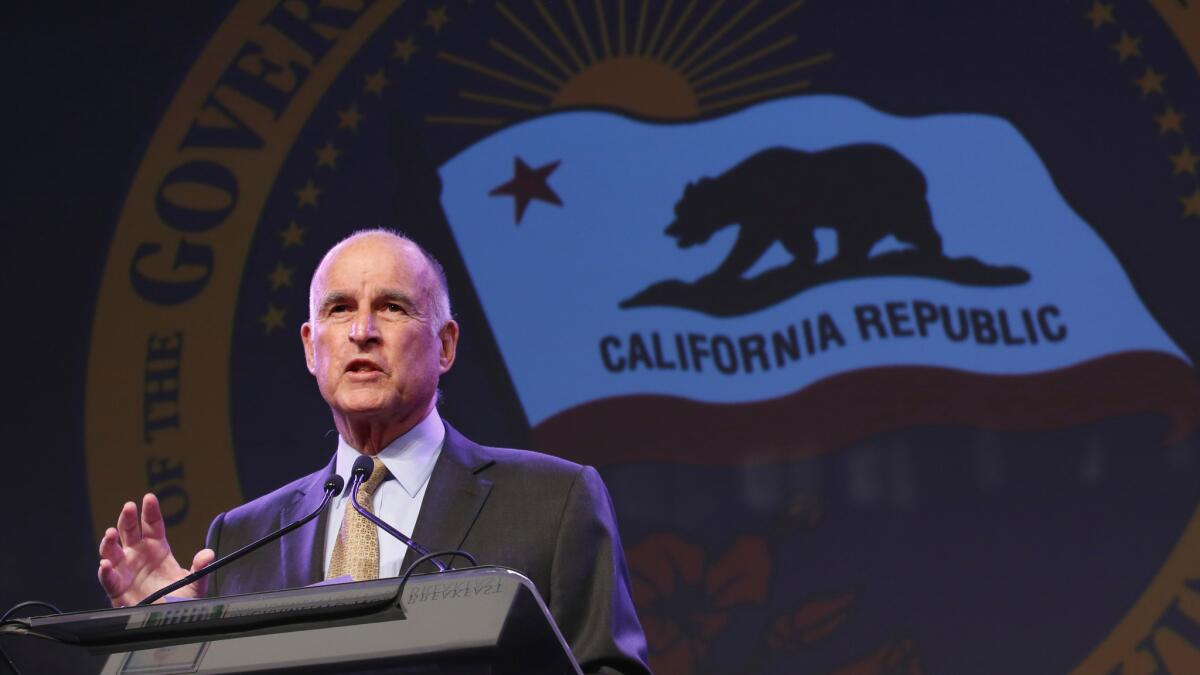Nearly 7 million Californians will be automatically enrolled in state-run retirement savings plan under new law

- Share via
Reporting from Sacramento — Nearly 7 million workers for California companies will be automatically enrolled in a new state-run retirement program under a bill signed Thursday by Gov. Jerry Brown.
The law requires all California companies with at least five employees to enroll their workers in the new California Secure Choice Retirement Savings Program if they do not offer their own retirement savings plan.
State Senate leader Kevin de León (D-Los Angeles), who wrote the bill, called it the “largest expansion of retirement security since the New Deal.”
“This bill is about personal responsibility,” he said. “The retirement insecurity crisis is looming on the near horizon.”
Nearly all private workers will be eligible for the plan, but they aren’t likely to be able to start putting money into the system until 2018.
State officials said earlier this month that it could take months and possibly more than a year to work out the details before they could start enrollment.
At a news conference Thursday morning, Brown described the program as a “step forward,” especially in an age of “spend now and worry about it later.”
“This is save now and prepare for later,” he said.
The retirement program will be overseen by a state board, but most of the administrative work, including investing money for the program, will be outsourced to private companies. Those firms will need to be chosen before enrollment can begin.
Though structured as an individual retirement program, Secure Choice will operate much like a 401(k).
Workers without a workplace retirement account will automatically contribute 3% of their wages into Secure Choice, though that amount can be adjusted and workers can also opt out. The board can also implement automatic escalation of employee contributions, which will be no more than 1 percentage point annually with a ceiling of 8%, unless workers choose otherwise.
Employers are not required to contribute to the plan.
The program’s funds will be used to invest in a “diversified portfolio” focused on “long-term financial growth,” according to the governor’s office. The retirement plan is not guaranteed by the state, meaning it is not responsible for any potential losses by retirement savers.
Auto-enrollment has become popular in private sector pensions because it allows an employee to start saving immediately without much of a delay, said Olivia Mitchell, director of the pension research council at the University of Pennsylvania’s Wharton School.
The accounts will move with workers if they change jobs, and there will be a penalty if money is withdrawn before retirement.
California is one of a handful of states that have implemented state-sponsored retirement initiatives and about a dozen other states are studying such programs, said Geoff Sanzenbacher, research economist at the Boston College Center for Retirement Research.
“California is an early mover,” Mitchell said. “There are many other states waiting to see, and cities waiting to see, what California adopts and how the implementation is going to work.”
A major question is whether low-income workers, who are some of the plan’s main targets, will have the ability to save more, she said.
“They may be auto-enrolled but if they’re living hand-to-mouth … then maybe it turns out to be much less successful than it has been for higher-wage workers,” Mitchell said.
The bill was opposed by some investment industry organizations, such as the Investment Company Institute trade group, which sent a letter to Brown in August opposing the program.
The group has argued that state-run plans would compete against privately run ones and could amount to unfair competition for the trade group’s members.
For more business news, follow me @smasunaga
UPDATES:
2:10 p.m.: This article was updated with additional reporting.
This article was originally published at 10:20 a.m.
More to Read
Inside the business of entertainment
The Wide Shot brings you news, analysis and insights on everything from streaming wars to production — and what it all means for the future.
You may occasionally receive promotional content from the Los Angeles Times.








